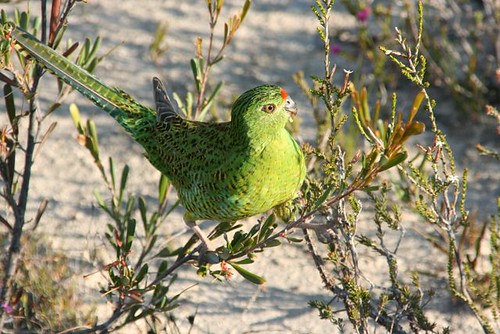Rare bird nearly extinct: experts
 Monday, January 20, 2014 at 2:03
Monday, January 20, 2014 at 2:03  Western Ground Parrot (Pezoporus flaviventris) in the wild in Fitzgerald River National Park. Photo: Brent BarrettEnvironmental conservationists fear WA’s rarest bird, the western ground parrot, is on the brink of extinction, with an estimated 110 birds left in the wild.
Western Ground Parrot (Pezoporus flaviventris) in the wild in Fitzgerald River National Park. Photo: Brent BarrettEnvironmental conservationists fear WA’s rarest bird, the western ground parrot, is on the brink of extinction, with an estimated 110 birds left in the wild.
Historically found from Jurien Bay to Israelite Bay and as far north as Eneabba, the parrot’s populations are now restricted to Fitzgerald River National Park and Cape Arid National Park, and have disappeared from Waychinicup National Park over the past decade.
Driving the bird’s decline is predation by foxes and cats, loss of habitat and bushfires, and Friends of the Western Group Parrot president David Taylor said it was imperative a captive breeding and release facility was built if the bird’s numbers were to be boosted.
“The outlook is if the declining trend continues the bird could be extinct in the next 10 years, but one bushfire and they could be gone tomorrow,” he said.
Anne Bondin, who was one of the group’s founding members in 2003, said the species was in a “precarious situation” and “a heartbeat away from being lost forever”.
“If nothing is done we will have a bird that is unique to WA disappear forever,” she said.
“Once it is extinct we can’t bring it back … I would like to think people’s children and grandchildren would like to see the parrot existing in our landscape.”
Department of Parks and Wildlife staff and volunteers spent more than 2000 hours conducting 10 surveys of the parrot in the two national parks last year to monitor existing and detect new populations.
A cat baiting program called Eradicat is being trialled in both national parks with the view of integrating cat control with existing fox control to benefit the western ground parrot, as well as other endangered fauna such as Gilbert’s potoroo and the noisy scrub bird.
Ms Bondin said seven birds have been kept in captivity to develop husbandry techniques, and a captive breeding and release program was hoped to be set up as soon as possible. “It is an insurance population, so if a bushfire happened there are at least some birds remaining alive,” she said.
“People think, ‘oh it’s OK, there are 110 birds’ but one lightning strike and fire and they could be gone … we need to boost the numbers out there.”
Mr Taylor said it would cost about $500,000 to set up a captive breeding and release program, and he was dissatisfied with a lack of Government funding.
“I am very disappointed with the State Government’s attitude towards critically endangered specifies, including the western ground parrot,” he said.
“They do not seem to be interested in conserving the bird.”

